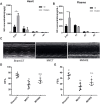Honokiol Ameliorates Post-Myocardial Infarction Heart Failure Through Ucp3-Mediated Reactive Oxygen Species Inhibition
- PMID: 35264952
- PMCID: PMC8899544
- DOI: 10.3389/fphar.2022.811682
Honokiol Ameliorates Post-Myocardial Infarction Heart Failure Through Ucp3-Mediated Reactive Oxygen Species Inhibition
Erratum in
-
Corrigendum: Honokiol ameliorates post-myocardial infarction heart failure through Ucp3-mediated reactive oxygen species inhibition.Front Pharmacol. 2022 Sep 27;13:1000887. doi: 10.3389/fphar.2022.1000887. eCollection 2022. Front Pharmacol. 2022. PMID: 36238543 Free PMC article.
Abstract
Post-myocardial infarction heart failure (post-MI HF) is one of the leading global causes of death, and current prevention and treatment methods still cannot avoid the increasing incidence. Honokiol (HK) has previously been reported to improve myocardial ischemia/reperfusion injury and reverse myocardial hypertrophy by activating Sirt1 and Sirt3. We suspect that HK may also have a therapeutic effect on post-MI HF. In this study, we aimed to investigate the efficacy and mechanism of HK in the treatment of post-MI HF. We found that HK inhibited myocardial reactive oxygen species (ROS) production, reduced myocardial fibrosis, and improved cardiac function in mice after MI. HK also reduced the abnormality of mitochondrial membrane potential (MMP) and apoptosis of cardiomyocytes caused by peroxide in neonatal cardiomyocytes. RNAseq results revealed that HK restored the transcriptome changes to a certain extent and significantly enhanced the expression of mitochondrial inner membrane uncoupling protein isoform 3 (Ucp3), a protein that inhibits the production of mitochondrial ROS, protects cardiomyocytes, and relieves heart failure after myocardial infarction (MI). In cardiomyocytes with impaired Ucp3 expression, HK cannot protect against the damage caused by peroxide. More importantly, in Ucp3 knockout mice, HK did not change the increase in the ROS level and cardiac function damage after MI. Taken together, our results suggest that HK can increase the expression of the cardioprotective protein Ucp3 and maintain MMP, thereby inhibiting the production of ROS after MI and ameliorating heart failure.
Keywords: UCP3; heart failure; honokiol; myocardial infarction; reactive oxygen species.
Copyright © 2022 Liu, Tang, Li, Su, Zhu, Dou, Liu, Pei, Yang, Ye and Chen.
Conflict of interest statement
The authors declare that the research was conducted in the absence of any commercial or financial relationships that could be construed as a potential conflict of interest.
Figures







Similar articles
-
Genetic deletion of uncoupling protein 3 exaggerates apoptotic cell death in the ischemic heart leading to heart failure.J Am Heart Assoc. 2013 May 20;2(3):e000086. doi: 10.1161/JAHA.113.000086. J Am Heart Assoc. 2013. PMID: 23688674 Free PMC article.
-
Role of uncoupling protein 3 in ischemia-reperfusion injury, arrhythmias, and preconditioning.Am J Physiol Heart Circ Physiol. 2013 May;304(9):H1192-200. doi: 10.1152/ajpheart.00592.2012. Epub 2013 Mar 1. Am J Physiol Heart Circ Physiol. 2013. PMID: 23457013 Free PMC article.
-
Uncoupling protein 3 deficiency impairs myocardial fatty acid oxidation and contractile recovery following ischemia/reperfusion.Basic Res Cardiol. 2018 Oct 29;113(6):47. doi: 10.1007/s00395-018-0707-9. Basic Res Cardiol. 2018. PMID: 30374710 Free PMC article.
-
Mitochondrial oxidative metabolism and uncoupling proteins in the failing heart.Heart Fail Rev. 2015 Mar;20(2):227-49. doi: 10.1007/s10741-014-9457-4. Heart Fail Rev. 2015. PMID: 25192828 Review.
-
Mitochondrial ROS in myocardial ischemia reperfusion and remodeling.Biochim Biophys Acta Mol Basis Dis. 2020 Jul 1;1866(7):165768. doi: 10.1016/j.bbadis.2020.165768. Epub 2020 Mar 12. Biochim Biophys Acta Mol Basis Dis. 2020. PMID: 32173461 Review.
Cited by
-
Honokiol and Alpha-Mangostin Inhibit Mayaro Virus Replication through Different Mechanisms.Molecules. 2022 Oct 29;27(21):7362. doi: 10.3390/molecules27217362. Molecules. 2022. PMID: 36364188 Free PMC article.
-
Recent Progress in Nano-TCM Active Ingredient Co-Delivery Systems for Inflammation-Mediated Diseases.Int J Nanomedicine. 2025 Aug 2;20:9573-9596. doi: 10.2147/IJN.S526731. eCollection 2025. Int J Nanomedicine. 2025. PMID: 40771757 Free PMC article. Review.
-
2-APQC, a small-molecule activator of Sirtuin-3 (SIRT3), alleviates myocardial hypertrophy and fibrosis by regulating mitochondrial homeostasis.Signal Transduct Target Ther. 2024 May 15;9(1):133. doi: 10.1038/s41392-024-01816-1. Signal Transduct Target Ther. 2024. PMID: 38744811 Free PMC article.
-
Exploring the potential of honokiol as a treatment for cardiovascular disease (Review).Biomed Rep. 2025 Jun 10;23(2):134. doi: 10.3892/br.2025.2012. eCollection 2025 Aug. Biomed Rep. 2025. PMID: 40530396 Free PMC article. Review.
References
LinkOut - more resources
Full Text Sources
Other Literature Sources
Research Materials
Miscellaneous

